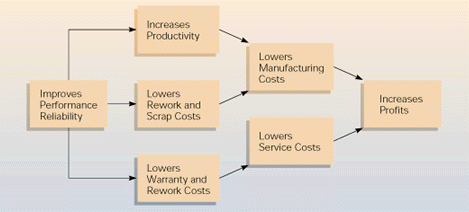Texts belong to their owners and are placed on a site for acquaintance.
Strategy, Manufacturing, and Materials Management
In Chapter 12, we introduced the concept of the value chain and discussed a number of value creation activities, including production, marketing, materials management, R&D, human resources, and information systems. In this chapter we will focus on two of these activities--production and materials management--and attempt to clarify how they might be performed internationally to (1) lower the costs of value creation and (2) add value by better serving customer needs. We will discuss the contributions of information technology to these activities. In later chapters, we will look at other value creation activities in this international context (marketing, R&D, and human resource management).
In Chapter 12, we defined production as "the activities involved in creating a product." We used the term production to denote both service and manufacturing activities, since one can produce a service or produce a physical product. In this chapter, we focus more on manufacturing than on service activities, so we will use the term manufacturing rather than production. We defined materials management as "the activity that controls the transmission of physical materials through the value chain, from procurement through production and into distribution." Materials management includes logistics, which refers to the procurement and physical transmission of material through the supply chain, from suppliers to customers. Manufacturing and materials management are closely linked, since a firm's ability to perform its manufacturing function efficiently depends on a continuous supply of highquality material inputs, for which materials management is responsible.
The manufacturing and materials management functions of an international firm have a number of important strategic objectives.1 Two important objectives shared by

Figure 16.1
The Relationship between Quality and Costs
Source: Reprinted from "What Does Product Quality Really Mean? by David A. Garvin, Sloan Management Review 26 (Fall 1984), Figure 1, p. 37, by permission of the publisher. Copyright 1984 by Sloan Management Review Association. All rights reserved.
both manufacturing and materials management are to lower costs and to simultaneously increase product quality by eliminating defective products from both the supply chain and the manufacturing process.2
These two objectives are not independent of each other. As illustrated in Figure 16.1, the firm that improves its quality control will also reduce its costs of value creation. Improved quality control reduces costs in three ways:
- Productivity increases because time is not wasted manufacturing
poor-quality products that cannot be sold. This saving leads to a direct
reduction in unit costs.
- Increased product quality means lower rework and scrap
costs.
- Greater product quality means lower warranty and rework costs.
The effect is to lower the costs of value creation by reducing both manufacturing and service costs.
The main management technique that companies are utilizing to boost their product quality is total quality management (TQM). TQM is a management philosophy that takes as its central focus the need to improve the quality of a company's products and services. The TQM concept was developed by a number of American consultants such as the late W. Edward Deming, Joseph Juran, and A.V. Feigenbaum.3 Deming identified a number of steps that should be part of any TQM program. He argued that management should embrace the philosophy that mistakes, defects, and poor-quality materials are not acceptable and should be eliminated. He suggested that the quality of supervision should be improved by allowing more time for supervisors to work with employees and by providing them with the tools they need to do the job. Deming recommended that management should create an environment in which employees will not fear reporting problems or recommending improvements. He believed that work standards should be defined not only as numbers or quotas, but also should include some notion of quality to promote the production of defect-free output. He argued that management has the responsibility to train employees in new skills to keep pace with changes in the workplace. In addition, he believed that achieving better quality requires the commitment of everyone in the company. The growth of international standards has also focused greater attention on the importance of product quality. In Europe, for example, the European Union requires that the quality of a firm's manufacturing processes and products be certified under a quality standard known as ISO 9000 before the firm is allowed access to the EU marketplace. Although the ISO 9000 certification process has proved to be a somewhat bureaucratic and costly process for many firms, it does focus management attention on the need to improve the quality of products and processes.4
In addition to the objectives of lowering costs and improving quality, two other objectives have particular importance in international businesses. First, manufacturing and materials management must be able to accommodate demands for local responsiveness. As we saw in Chapter 12, demands for local responsiveness arise from national differences in consumer tastes and preferences, infrastructure, distribution channels, and host - government demands. Demands for local responsiveness create pressures to decentralize manufacturing activities to the major national or regional markets in which the firm does business.
Second, manufacturing and materials management must be able to respond quickly to shifts in customer demand. In recent years time - based competition has grown more important.5 When consumer demand is prone to large and unpredictable shifts, the firm that can adapt most quickly to these shifts will gain an advantage. As we shall see, both manufacturing and materials management play critical roles here. This issue surfaced in the opening case. One of Li & Fung's core competencies is its ability to respond to customer needs in a timely manner by ensuring that products arrive just when they are needed, not too late or too soon (which would mean the customer would have to bear the costs of storing the inventory until it was needed).